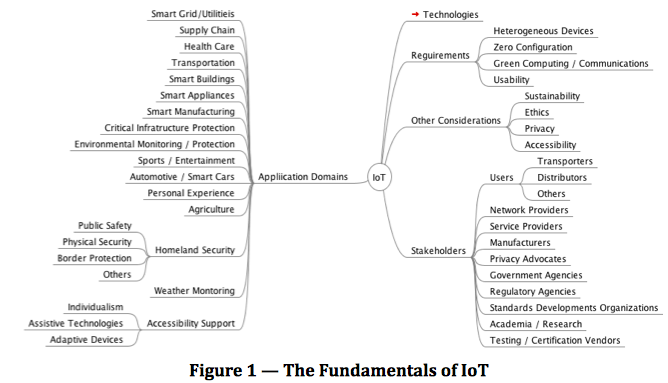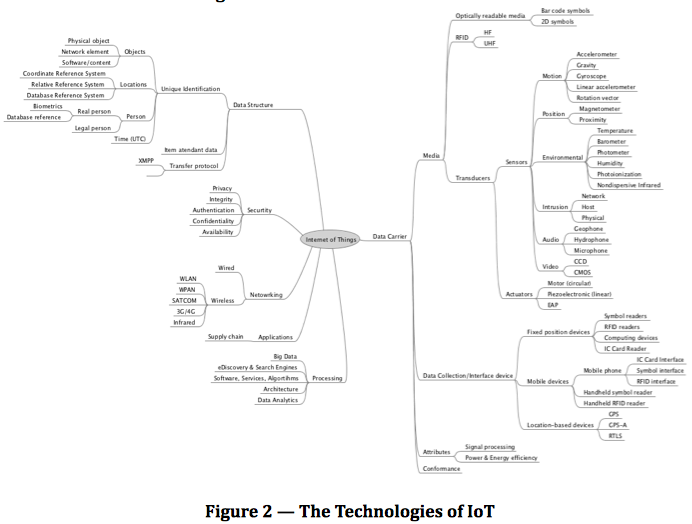The Internet Of Things (IoT) - The Fundamentals
(Editors note: This is a bold force sweeping into our society. It's not just about software, but everyday devices like the ones you buy at Home Depot. Take five minutes to learn about something that is already touching your life and coming on like a silent avalanche.)
It is difficult today to look through on-line technology blogs, magazines, or advertising literature and not find some claim about the Internet of Things (IoT) or Machine-to-Machine (M2M) communications. Claims of self-repairing machines and individually targeted advertising as seen in Spielberg’s 2002 Minority Report harken to a day where machines are able respond (and shape) our needs and wants. Smart Homes, Smart Cars, Smart Cities, Smart Grids, and eHealth beckon us to a world of computer-assisted living with claims of an improved quality of life.
Likewise there is no shortage of existing technologies claiming that they are the foundation of IoT and M2M. RFID vendors claim IoT is merely RFID+. Sensor manufacturers note that IoT and M2M are nothing more than applications of their technology. Mobile device companies assert that IoT is as simple as scanning a QR Code on a poster to access entertainment venues, creating reservations, and affecting payment through their electronic purse. However, IoT and M2M are so much more and those claims are a disservice to the vision.
Since 2008, there have been no fewer than 40 European Union funded projects that touch upon the Internet of Things. In October, 2010, China’s IoT market size was expected to top 200 billion yuan (about 30 billion U.S. dollars) and to top 750 billion yuan by 2015. Intel Corporation predicts there will be 31 billion devices connected to the Internet by 2020. In a statement to shareholders, the Ericsson CEO repeated the company's vision of 50 billion connections by 2020. While it is certainly good to see that this vision is poised for phenomenal growth, the question remains, “What is the Internet of Things?” While there are as many definitions as there are claimants to the leadership of IoT, one that has withstood the test of time is from the 2009 CASAGRAS Final Report “A global network infrastructure, linking physical and virtual objects through the exploitation of data capture and communication capabilities. This infrastructure includes existing and evolving Internet and network developments. It will offer specific object-identification, sensor and connection capability as the basis for the development of independent cooperative services and applications. These will be characterised by a high degree of autonomous data capture, event transfer, network connectivity and interoperability.”
Figure 1 — The Fundamentals of IoT

Figure 1 shows the fundamentals of IoT including an incomplete list of application domains, stakeholders involved, requirements, other considerations, and technologies, while Figure 2 drills down into the technologies of IoT. Figure 1 also points out a major concern of privacy advocates , namely that IoT may lead to the harvesting of IoT data by government and commercial interests, leading to NSA-fed fears that smart systems could gang up on their creators, in the way they did in “The Matrix”, the 1999 film in which human beings are plugged into machines that simulate reality to control humans and harvest their bodies' heat and electrical activity. Such a scenario is likely to remain science fiction. However, smart systems may be vulnerable to malfunctioning or attacks by hackers.
Figure 2 — The Technologies of IoT

And while Figure 1 provides a snapshot of potential applications, it is the supply chain where this author believes the first widely accepted applications will be found. Granted the Smart Home is well into the implementation phase; however each vendor has a proprietary solution, whereby the supply chain demands interoperable solutions.
By means of example, envision a supplier that provides its product in returnable containers; fully expecting the container to be returned on a timely basis. After a sufficient delay, the supplier contacts the customer to request the return of the container, but the customer says, “We do not have your container.” The supplier then goes to his database identifies the container and informs the customer, “Our real-time global tracking system shows that our container is located in the northeast corner of the building you designate as Warehouse 13.” The container is then returned in short order.
What does it take to provide such traceability? RFID, you say? What the supply chain has learned is that for RFID to work as envisioned, everyone needs to implement the technology. In our fictitious example above, if the supplier asked the customer to track the supplier’s containers, the customer might agree, provided that the supplier agreed to pay for RFID readers at the customer’s locations. Absent such a universal implementation the supplier needs a tracking system that can extend beyond the “black hole” encountered when goods leaving the shipping doors.
Such a tracking system needs to rely on the same ubiquitous communications available with our mobile phones, namely 3G, 4G, LTE, and LTE Advanced. By combining those communication technologies with High Sensitivity GPS and A-GPS (Assisted GPS) it is possible to bring the functionality of outdoor GPS inside. Further, technologies such as Multipath TCP, currently being used by Apple in iOS 7 to combine cellular and Wi-Fi for use by its voice-query Siri technology could enable devices to easily switch between communication modes, maintaining continuity of the connection.
Several years ago a concept known as etPallet was introduced. Should Amblin Entertainment ask, “et” is an abbreviation for “electronics and telecommunications”, but might also speak to the pallet’s ability to call home. This device includes location-based services, cellular/satellite messaging and location services, ISO/IEC/IEEE 8802-15-4 and ISO/IEC/IEEE 8802-11 messaging, RFID, sensors, user memory, and an inductively charged lithium imide power supply. The power supply may be replaced when energy harvesting when the technology becomes more efficient and practical.
RFID was devastated by early predictions of a five-cent tag, that chilled the emerging market . This is not a five-cent device, nor is it a five-dollar device. Efforts in 2011 to establish a bill-of-material cost came in at $17.00 for a quantity of one, yielding a sale price of approximately $50.00.
A remaining issue is that of variable communication costs in which roaming charges for a device traveling between carriers and countries might make the device impractical. A solution to address roaming charges could be included in a universal SIM (uSim), currently being developed within 3GPP (3rd Generation Partnership Project). The name “3GPP” is misleading because this organization also developed the standards for 4G and LTE communications.
Another remaining issue is a method of unique identification for each of the elements in this IoT application, a discussion for an upcoming article.
Written by Craig Harmon specifically for The Bar Code News (tm).
(Why not bookmark this page in your browser for future reference and share with colleagues using the buttons below.)
